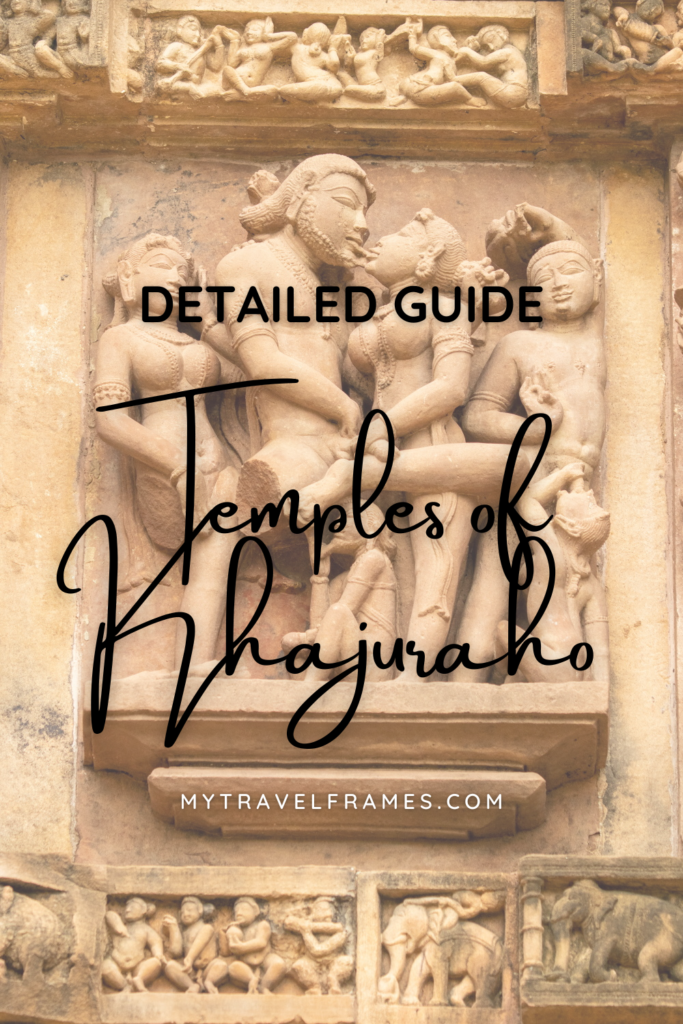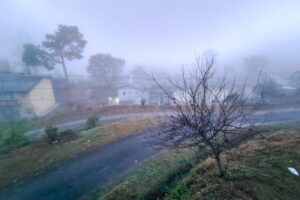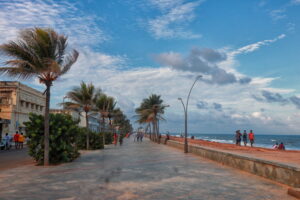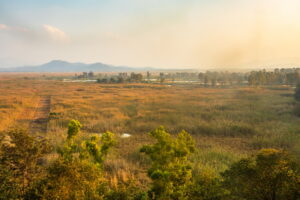Khajuraho is famous for its temples. The erotic sculptures over the temple walls, which give fame to Khajuraho, amount to only 10% of the artworks that are still preserved on the temple walls. The remaining artworks are images of Hindu gods and goddesses, daily moments from ancient life, and war scenes. The intricate details of these sculptures struck visitors with awe, even in the modern era. The artwork symbolically represents four goals of life considered necessary in Hinduism – dharma, kama, artha and moksha. You can spend hours looking at these works even if you are not an art scholar.
Pin the image below and read this article later!
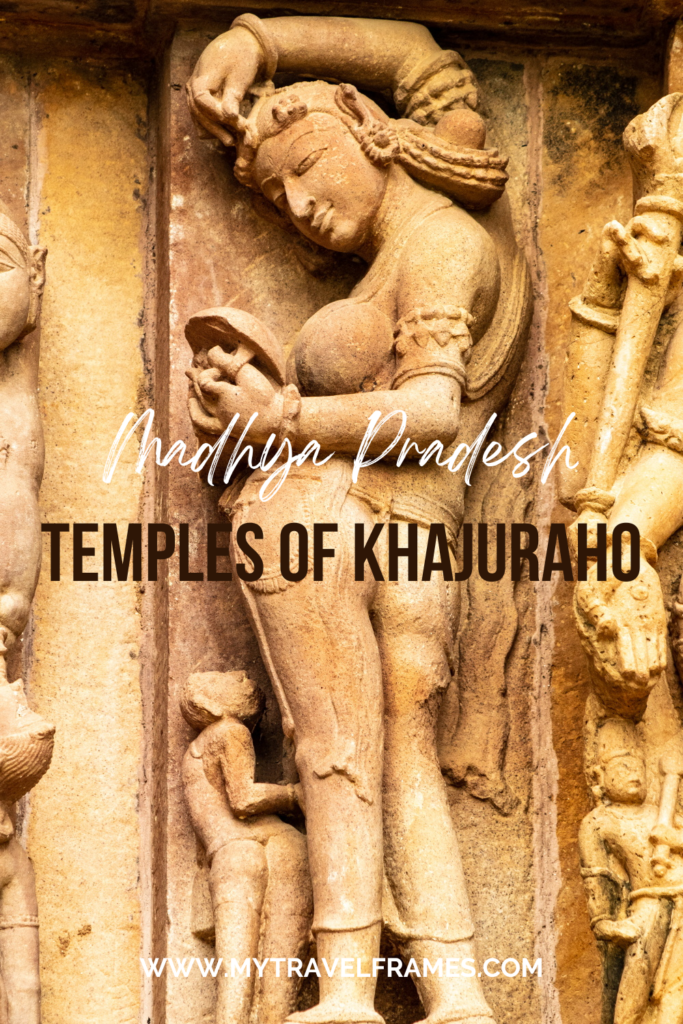
Table of Contents
History of Khajuraho and its Temples
The name of Khajuraho and its temples were mentioned in the narratives of Al Biruni (1022 CE) and Ibn Battuta (1335 CE). Al Biruni accompanied Mahmud of Ghazni during the attack on Kalinjar. He described Khajuraho as Jajahuti. A century later, when Ibn Battuta visited India, he described Kajjara (present-day Khajuraho) as a place of yogis who practice extreme asceticism.
Khajuraho group of temples were built during the Chandela Dynasty, which ruled a significant part of central India from the 9th century to the 13th century. The Chandelas were originally from the Rajput clan and ruled as feudatories of the Gurjara-Pratiharas of Kannauj. From the time of Yasovarman, Chandelas started to become independent and ruled as a sovereign power.

Chandelas were great admirers of art and architecture. They constructed 85 temples in Khajuraho, most of which are Hindu temples; the remaining are Jain temples. Of these, only about 23 temples have survived today. The temples in the Western group still bear the excellence of the intricate artworks on the temple walls.
It is said that the name Khajuraho came from the Sanskrit word Khajuravahaka (meaning date-palm bearer). Local legends state the temples had two golden date palm trees as their gate. But these date palm trees were missing when the temples were rediscovered by a British Surveyor, T.S. Burt, guided by the locals.
Alexander Cunningham, another surveyor from the Asiatic Society in Kolkata, later reported in detail about these temples, grouping them as the Western group, the Eastern Group and the Southern group of temples. This nomenclature is still used the same way today.

The Architecture of Khajuraho Temples
All temples that exist today have the same type of architecture. The more prominent temples were constructed using the 64-pada grid design, while the smaller temples followed the 9, 16, 36, and 49 grid plans.
The layout of Hindu temples is a symmetrical, concentric, self-repeating structure around a core, which is the seat of the deity called garbhagriha. This geometric grid of architecture is called vastu-purusha-mandala – Mandala means circle, Purusha is the universal essence at the core of Hindu tradition, while Vastu means the dwelling structure.
Each temple is constructed on a raised platform with a granite base. The temples are made of sandstones that were abundant in nearby rivers. The stones were put together by mortise and tenon joints. Subsidiary shrines surround the main temple. The columns were made with megaliths that may weigh up to 20 tons.
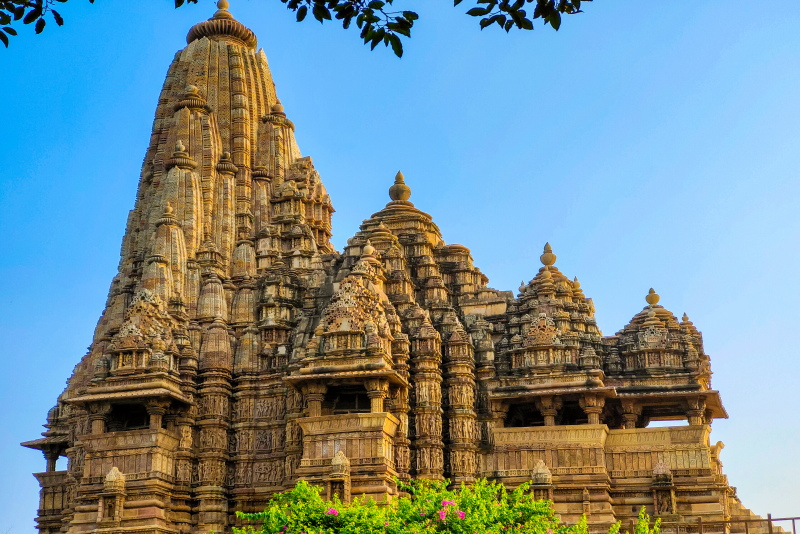
It is said that the stones were laid layer by layer, and finally, the spire or shikara was fitted at the top. The way of carrying these huge stones was by making temporary platforms of sand and soil surrounding the temple on which these stones were pulled onto the top. Finally, the surrounding soil or sand was cleared, and temples got their final forms.
The entrance of the larger temples has an arch at the top, followed by ardhamandapa. It is followed by mandapa and mahamandapa. After mahamandapa comes the place of the deity or the garbhagriha. The space between mahamandapa and garbhagriha is called antarala. There is a path surrounding the garbhagriha which is called pradakhsina. The smaller temples lack ardhamandapa, mandapa and pradakhshina.
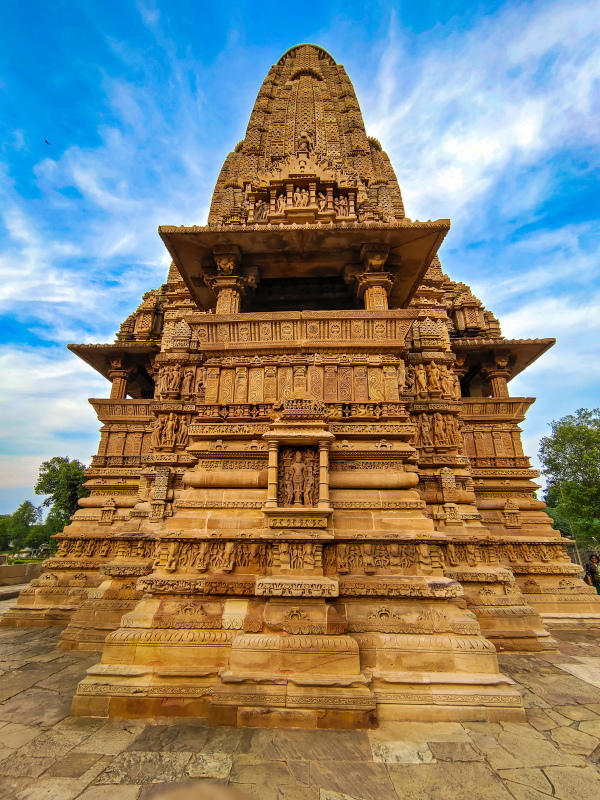
Above the vastu-purusha-mandala is the spire or dome called shikara or vimana. The top of the shikara is like a lotus flower. The main temple has an ambulatory to walk around. The pillars, arches, ceilings and walls (both inside and outside) have highly ornate carvings or images of the four just and necessary pursuits of life – kama, artha, dharma, and moksha.
Art and Sculpture of Khajuraho Temples
The art and sculptures on the temple walls, pillars, and ceilings represent many figures and scenes from life. Outside the temple, the scenes depict everyday life, moments from the war, mythical stories and erotic imagery. The figures are of gods and goddesses and their different forms: apsaras, animals and humans.
Daily scenes like women putting on makeup, musicians making music, farmers and potters busy in their work, mothers with children, nursing mothers, couples in the forest and many other moments are depicted as carvings on the walls.

The twisting, broad-hipped, high-breasted nymphs attract attention with their bejewelled and contoured bodies. These apsaras are busy putting on makeup, washing hair, playing games, writing letters and taking out a thorn from the feet.
The love-making scenes or the sex postures are the most famous of all the carvings on Khajuraho temples. However, these erotic carvings constitute only 10% of the sculptures still intact on the temple walls.
The boldness, the curves, the postures, the expressions and the actions in each of these erotic carving makes them unique. Some scholars suggest that these are tantric sexual postures. Other scholars suggest that the erotic arts are part of the Hindu tradition of treating kama as essential to human life. You can also interpret them as a part of sex education in medieval India.

Whatever the cause and interpretation, these images are an example to the world of how open and welcoming society was in the medieval Hinduism era. The scholars and interpreters, even the guides, feel a little awkward explaining them. But think of the artists, the sculptors and the kings who commissioned them. They were ahead of their time regarding their thoughts, beliefs and resilience.
The Prominent Temples of Khajuraho
The monuments of Khajuraho have been enlisted as a UNESCO World Heritage Site since 1986. The temples rediscovered or excavated in Khajuraho are classified into three groups – the Western, the Eastern, and the Southern. The western temple group is the most beautiful, and the artworks are mostly preserved in this group of temples. If you have a very short time to spend in Khajuraho, then at least you must visit the western group of temples.
Entry Time: sunrise to sunset
Entry Fee:
- Indian – adult – ₹35, children (below 15 years) – nil
- Foreigner – ₹250
| Group | Temples |
| Southern Group | Chausath Yogini Temple Lalguan Mahadev Temple Lakshmana Temple Lakshmi Temple Varaha Temple Kandariya Mahadev Temple Jagadambi Temple Chitragupta Temple Visvanatha Temple Parvati Temple Nandi Temple Pratapeswar temple Matangeswar temple |
| Eastern Group | Hindu Temples Brahma Temple Javeri Temple Vamana Temple Jain Temples Adinatha Temple Parshvanatha Temple Shantinatha Temple Ghantai temple |
| Southern Group | Chaturbhuja Temple Duladeo Temple Beejamandal Temple Ruins |

Western Group of Temples
Chausath Yogini Temple
Chausath Yogini Temple is the oldest surviving temple in Khajuraho. It was built around 885 CE. The temple is built with granite blocks. The layout is rectangular, with a central courtyard and 65 small shrines forming the margin of the rectangle.
Only 35 of these 65 shrines have now survived. One of the shrines is larger than the others, which probably housed the statue of the goddess Durga. The other 64 shines presumably had statues of 64 yoginis. Like other yogini temples in India, these temples also have no roof.
Chausath Yogini Temple is located on the southern end of Shiv Sagar Lake outside the main western group temple complex. Ask your guide to take you to Chausath Yogini Temple before visiting the main temple premises.
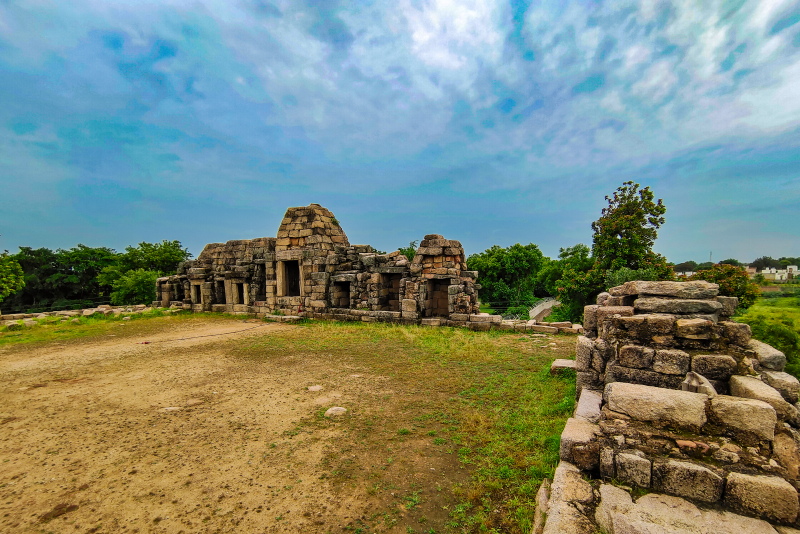
Lalguan Mahadev Temple
This is the second oldest surviving temple is Khajuraho, which dates back to 900 CE. This temple is also made of granite. This temple was constructed on the bank of a lake called Lalguan Sagar. The design is simple and small, with a pyramidal-shaped roof. It is a ruined Shiva Temple.
Lakshmana Temple
Lakshmana Temple is one of the finest temples in Khajuraho. King Yashovarman built the temple during the 10th century. The temple follows a Panchayatana layout, which means the main temple is surrounded by four subsidiary temples at four corners. The temple complex rests on a high platform on a granite base mostly hidden inside the ground. The high platform has detailed carvings on the outer wall, primarily scenes from war with a few erotic images as well.
In front of Lakshmana Temple, there are two other temples, which are Lakhshmi Temple and Varaha Temple. Immediately on the right side of Lakshmana Temple is the Matangeswar temple, which can be accessed only from outside.

The Lakshmana Temple is east-facing, like other temples in Khajuraho. A statue of a baby boy fighting with a lion is near the stairs. This statue is supposed to be the emblem of the Chandela Dynasty. It is said that these structures were at the top of the temple, which gradually fell with time and kept beside the temple.
The temple has an entrance porch called ardha-mandapa followed by mandapa, mahamandapa, antarala and grabhagriha. There is a declared toran above the entrance that welcomes visitors. The ardhamandapa opens to the mandapa, which finally opens to the large mahamandapa, which can accommodate more than 100 people.
The deity inside the garbhagriha is the four-armed Lord Vishnu in a standing posture. There is a path surrounding the garbhagriha for the followers to walk. On the inner walls of mahamandapa there are images of other gods and goddesses. The door to the sanctum or garbhagriha has carvings of Vishnu at the top, with images of Brahma and Shiva on two sides. Ten incarnations of Vishnu are also depicted at the sanctum door. The outer wall has two rows of carvings, including images of gods and goddesses, the apsaras or beautiful women, and love-making couples.

Lakshmi Temple
This temple is located in front of Lakshmana Temple. It is a simple construction resting on a square-shaped platform. The sanctum is small, with walls devoid of any sculptures. The shrine is of Goddess Lakshmi, although it is said that the original shrine was of Garuda.

Varaha Temple
Varaha Temple is located in front of the Lakshmana Temple. The design is simple. It has an elliptical pavilion with a pyramidal roof resting on many pillars. The shrine is of Varaha, an incarnation of Lord Vishnu. It is a giant monolithic statue made of sandstone. The statue is carved with numerous figures, including other gods and goddesses.
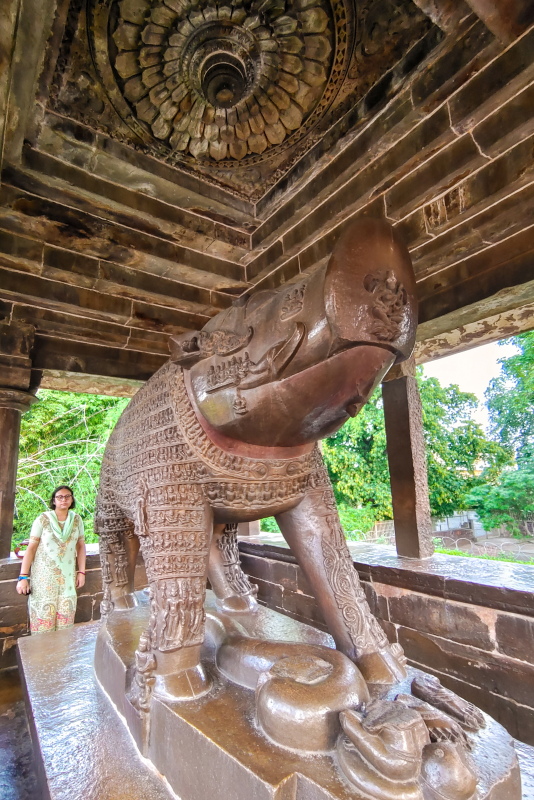
Kandariya Mahadev Temple
Kandariya Mahadev temple is the largest and most preserved Hindu Temple among all temples in Khajuraho. It is situated among the Western Group of Temples. This temple was constructed during the reign of Chandela King Vidyadhara, who fought against Mahmud of Ghazni. He defended his kingdom from the attack of Mahmud twice, and to celebrate his success, he constructed the Kandariya Mahadev temple dedicated to his family deity Shiva.
The temple is situated on an elevated platform of 13 ft in height. The maximum height of the temple is 102 ft in height. The entrance is decorated above like a torana leading to ardhamandapa, mandapa and mahamandapa that gradually increase in size and height. Then, the garbhagriha comes where the deity is placed. A large Shiva Linga is inside the sanctum.

From the outside, the temple roof looks like a mountain range, gradually gaining in height. The central tower, or the spire, comprises 84 mini spires around a central core, giving it the appearance of Mount Kailasa, which is believed to be the abode of God Shiva, according to Hinduism.
The exterior is carved with numerous sculptures of gods, goddesses, musicians, and apsaras. Among the images of gods, Agni, the god of fire, is prominent. There are also the image of Ganesha, Birbhadra and goddesses like the sculptures of Saptamatrikas.
The erotic sculpture panels are also a major attraction among tourists. The finely carved bodies engaged in mithuna (coitus) postures with delicate carvings of clothes and jewellery prove the high standard of art and sculpture during the Chandela Dynasty.
Like the Lakshmana Temple, four subsidiary shrines are on the same platform at four corners around the Kandariya Mahadev Temple.
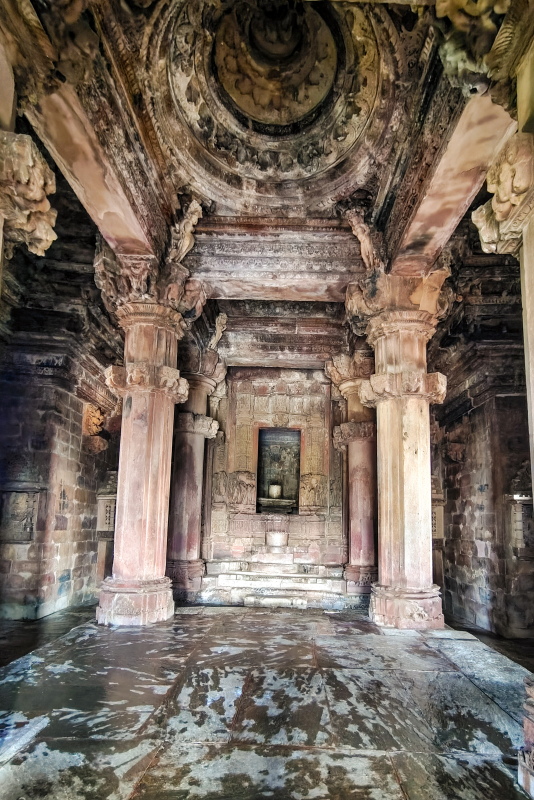
Jagadambi Temple
Jagadambi Temple is located beside Kandariya Mahadev temple. This temple also has rich sculptures on the exterior. The temple’s design is similar to the other western groups of temples, although it is not as grand as Lakshmana temple, Kandariya Mahadev temple or the Visvanath temple.
This temple was also built between the 10th and 12th centuries by the Chandela rulers. The sanctum has a giant Jagadambika statue, also known as Goddess Parvati.

Chitragupta Temple
Next to Jagadambi Temple is the Chitragupta temple. This temple was constructed in the early 11th century. This temple is dedicated to Lord Chitragupta or Lord Surya (Sun God). The design of the temple is very similar to the Jagadambi Temple.
The temple’s sanctum has a partially broken 7 ft tall statue of Surya riding a chariot of seven horses. He is shown standing, dressed in an armoured coat and boots, and holding lotus flowers. The sanctum door also features three similar but smaller images of Surya.
The temple’s exterior walls are covered with sculptures of erotic couples, surasundari, and various gods, including an 11-headed Vishnu. The Vishnu sculpture shows the god with ten incarnations in his supreme form. This rare representation is not seen elsewhere or mentioned in any historical text. The sculptures in Chitragupta Temple can be dated after the Vishvanath sculptures and before the Kandariya Mahadeva sculptures.

Visvanatha Temple
Like Lakshmana Temple and Kandariya Mahadev Temple, Visvantha Temple is another large temple in the Western Group of Temples in Khajuraho. This temple was constructed in the period between the Lakshmana Temple and the Kandariya Mahadev temple. As per the inscription, this temple was built during the reign of Chandela King Dhanga.
The temple was constructed in the same panchayatana style as the other two temples, which means one main shrine surrounded by four subsidiary shrines. At present, only two subsidiary shrines exist. One is of Nandi, and the other is of Shiva’s consort, Parvati.

The main shrine is in Nagara style, with an entrance porch (ardha-mandapa), a small hall (mandapa), the big hall (maha-mandapa), a vestibule (antarala) and finally a sanctum (garbhagriha). The stairs leading to the entrance porch are flanked on one side by a lion and on the other side by an elephant. The sanctum has a stone linga. There is a circumbulatory or passage surrounding the sanctum, which is called parikrama.
The exterior portion of the temple has sculptures of many deities, female figures such as apsaras, and mythical creatures like other temples. The apsaras are shown performing various day-to-day activities, such as applying sindoor (vermilion powder) to their foreheads and kohl to their eyes, wringing their hair after bathing, playing the flute, plucking thorns from their feet, dancing, admiring themselves in a mirror, dressing or simply posing provocatively. Their hairstyles, patterned garments, ornaments and expressive faces are noticeable in these sculptures.

Parvati Temple
Parvati Temple is located on the southwest of Visvanatha Temple. The temple has been restored heavily, with only one part of the front wall remaining. The arch above the sanctum door depicts Brahma, Vishnu and Shiva sculptures. Also, numerous erotic couple sculptures can be seen on the front wall on the side of the sanctum door.

Nandi Temple
The Nandi Temple is adjacent to the Visvanatha Temple on the east side. The design of the temple is like the Varaha Temple. It has twelve pillars supporting the roof. Inside, there is a giant statue of Nandi, who is the means of transport for Lord Shiva. Nandi Temple is also heavily decorated and contains beautifully carved images of animals and humans.
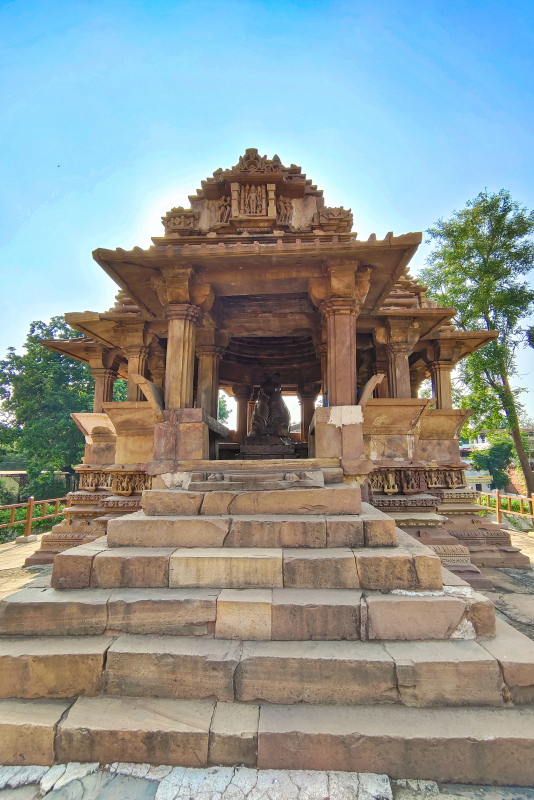
Pratapeswar temple
Pratapeswar Temple is the only temple in the Western Group of Temples with a very recent history. Maharaja Pratap Sing built this temple in the nineteenth century. He was a local ruler who took an interest in Khajuraho temples when the temples were rediscovered in the 19th century.
He built this temple to immortalise his name with the history of Khajuraho temples. The temple is not as rich in arts and sculpture as the other temples in Khajuraho, as the walls and interiors have hardly any carvings. But the main attraction of this temple is its roof. The roof is a conglomeration of three styles – a dome in front, a pagoda-like ceiling in between, and a Hindu temple shikara at the back.
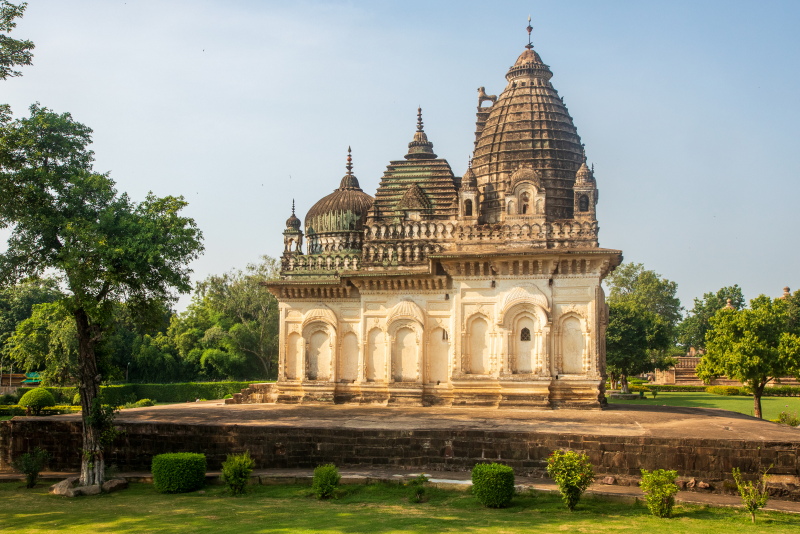
Matangeswar temple
Matangeswara Temple is a Shiva Temple that is located adjacent to Lakshmana Temple. It was constructed in the 10th century and is one of the oldest temples in Khajuraho. The design of the temple is in nagara style. The walls are devoid of any carvings.
According to history, a sage named Matanga manifested as a lingam and controlled the god of love. His hermitages were located at Khajuraho, Kedarnath, Varanasi and Gaya. These are now the sites of four Matangeswar (“Lord of Matanga”) temples.
Among the Hindu temples of Khajuraho, the Matangeswar Temple is the only active worship site. During Shivratri, a 3-day celebration happens in Matangeswar Temple, which witnesses a large number of gatherings during this time.

Light and Sound Show at The Western Group of Temples
In the evening, two light and sound show sessions are organised at the Western Group of Temples in Khajuraho. The first is in English, and the second is in Hindi. The play of lights over the temples and the story of the Chandela Dynasty, narrated by Amitabh Bachchan in his baritone voice, is really an experience to enjoy. Although the play of lights could be much better and there is a massive scope for improvement, I believe.
- Show time: English – 7:30 pm – 8:25 pm ; Hindi – 8:40 pm – 9:35 pm
- Entry Fee: Adult – ₹250, Children (5 years to 12 years) – ₹120
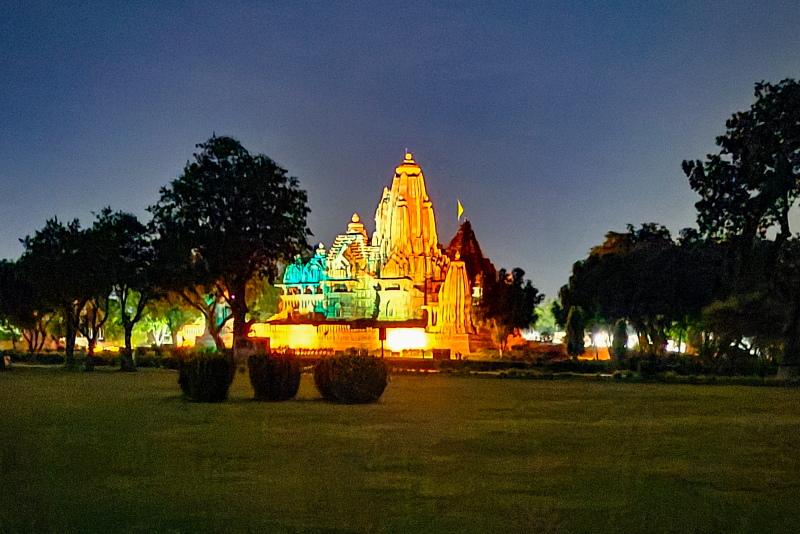
Eastern Group of Temples
Brahma Temple
Brahma Temple is one of the oldest temples in Khajuraho. It is located beside Sagar Lake and included in the Eastern Group of Temples in Khajuraho. The temple was constructed in the late ninth century or early tenth century. The design of the temple is simple, like the Lalguan Mahadev Temple. At present, the sanctum of Brahma Temple is only preserved.
The deity inside the sanctum is a four-faced lingam, which local worshippers had mistaken as four-faced Brahma and called a Brahma Temple. The temple is made of granite, apart from the shikara, which is made of sandstone. Externally, the garbhagriha is cruciform in shape and contains projections on each side. Internally, it is square and rests on 12 granite pilasters.

Javeri Temple
Javeri Temple is another old temple constructed in the early eleventh century and grouped as the Eastern Group of Temples in Khajuraho. It has an entrance porch followed by ardha-mandapa, which leads to the mandapa and the sanctum. The entrance porch has a beautiful makara toran. The entrance of the sanctum has nava-graha sculptures with Brahma, Vishnu and Shiva sculptures. The deity of the temple is headless Vishnu.

Vamana Temple
Near Brahma Temple, the Vamana Temple is located. Vamana Temple was constructed between 1050 AD and 1075 AD. This temple has an entrance, mandapa, antarala and garbhagriha. There are sculptures of gods and goddesses, nymphs and musicians over the external walls of the temple. The deity here is Vamana, one of the incarnations of Lord Vishnu.

Adinatha Temple
Adinatha Temple is a Jain Temple part of the Eastern Group of Temples in Khajuraho. The temple was constructed around the late 11th century. The architecture is similar to the Vamana Temple. At present, the vestibule and the sanctum are preserved only. The deity here is a basalt statue of Adinatha sitting on a cushioned seat decorated with lotus and diamond motifs.
The temple’s exterior walls have three bands of sculptures featuring apsaras (graceful women), flying vidyadhara couples, vyalas (mythical lion-like beings), and a dancer with musicians. Despite the shrine’s Jain affiliation, the external walls also feature carvings of the Hindu deities. The niches feature sculptures of the Jain Yakshinis like Ambika, Chakreshvari, and Padmavati.

Parshvanatha Temple
Parshvanatha Temple is the most preserved temple among the Jain Temples in The Eastern Group. This temple was constructed in the same period Dhanga ruled in the Chandela Dynasty. The original temple was dedicated to Adinatha, but that statue got lost in time. The Parshvanatah statue was established in the 19th century.
The Parshvanatha Temple is the largest among the Jain temples in Khajuraho. It has an entrance porch, a small hall, a large hall (mandapa), a vestibule, and a sanctum. The outer walls have sculptures of apsaras, flying couples, dancers, musicians and celestial beings. There are images of Hindu gods with consorts like Vishnu-Lakshmi, Rama-Sita, Balarama-Revati, Brahma-Brahmani etc.
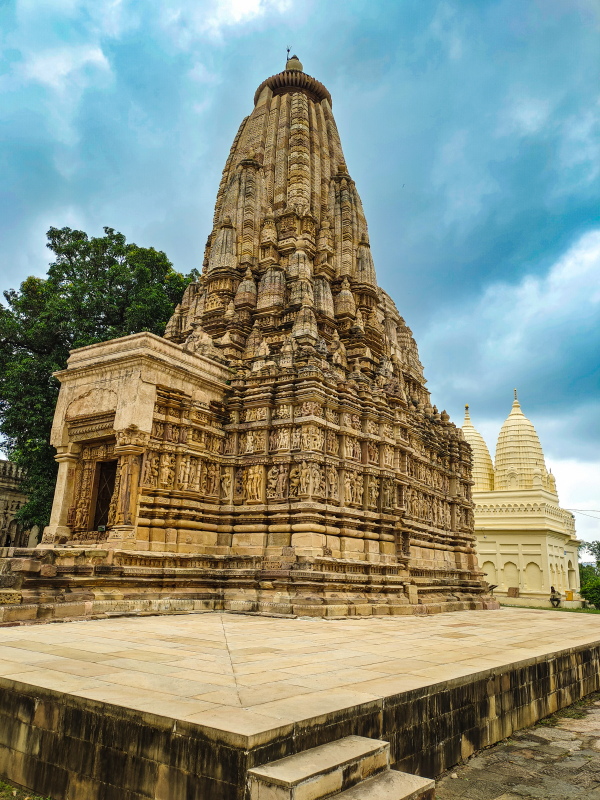
Shantinatha Temple
Shantinatha Temple is the main centre of Jain worship in Khajuraho. The original temple is incorporated into the new temple and has the main deity as Lord Shantinatha, along with 18 other shrines and numerous other Jain images.
The present-day temple is a renovated structure that is quadrangular in shape, with an open courtyard in the centre. It features an oblong enclosure of shrine cells depicting the older sculptures.
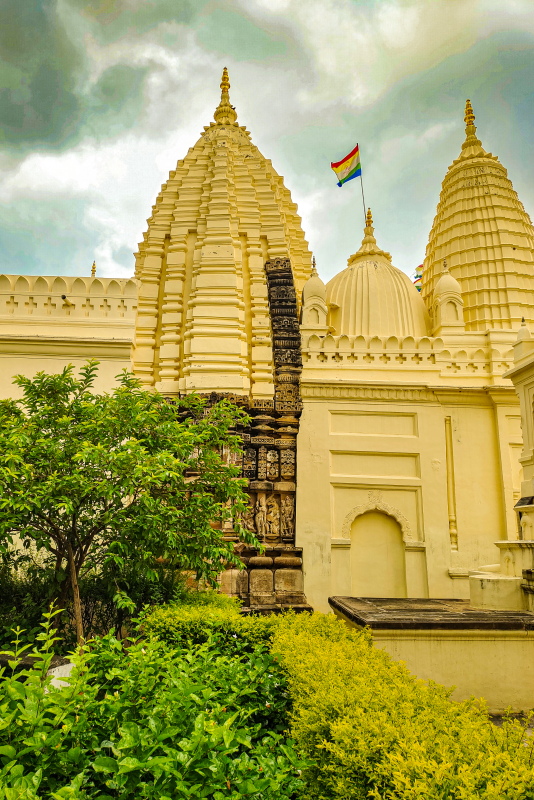
Ghantai temple
Ghantai Temple, or the Ghanti Temple, known locally, is a Jain Temple presently in a ruined state. The only surviving pillars, probably of the entrance porch and the maha mandapa, indicate the larger scale of the temple itself.
This temple was constructed during the era of Dhanga, the Chandela King and was of the same kind of architecture as Parshvanatha Temple. The surviving pillars feature a chain-and-bell (ghanti) motif, after which the temple is now known.
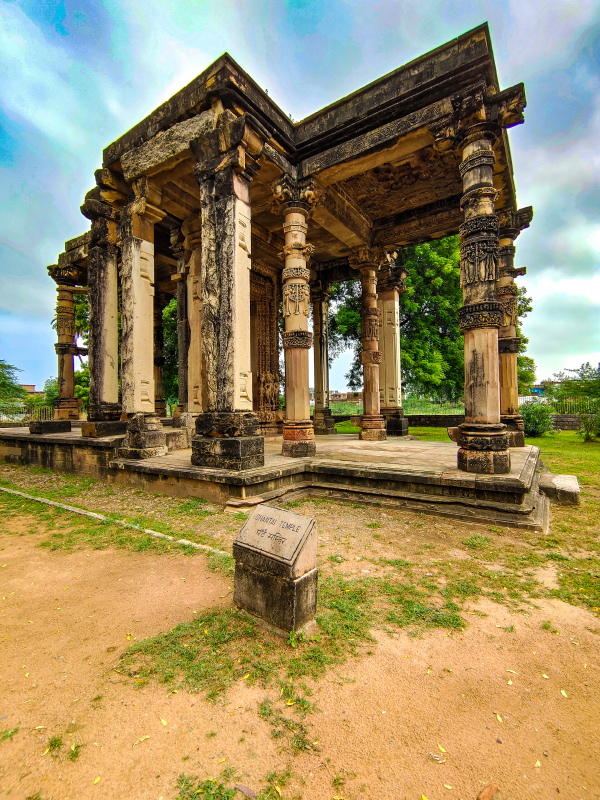
Southern Group of Temples
Chaturbhuja Temple
Chaturbhuj Temple is a Hindu temple that falls under the Southern Group of Temples in Khajuraho. As the temple is located in the village of Jatakari, it is also called Jatakari temple.
The temple architecture is categorised as a Nirandhara temple, which means there is no ambulatory path (pradakhina) surrounding it. The temple has an entrance porch, main hall, vestibule and a sanctum. Unlike the other temples in Khajuraho, Chaturbhuj Temple faces the western side, which makes this temple a perfect place to explore before sunset when the light falls directly on the deity.
The temple was built by Yasovarman of the Chandela Dynasty in 1100 AD. This is the only temple in Khajuraho which lacks erotic sculptures. The three bands on the exterior walls have images of gods and goddesses with dancers and musicians. The most attractive thing about this temple is the largest and most beautiful statue of Lord Vishnu in the sanctum. It is a 9-ft standing statue of four armed Vishnu carved out from a single stone called Chaturbhuj.

Duladeo Temple
Duladeo Temple is another temple from the Southern Group. This temple is a Shiva Temple. Duladeo means the “Holy Bridegroom”, which signifies Lord Shiva. The architecture of Duladeo Temple is the same as that of Chaturbhuj Temple. The Nirandhara style of architecture is followed here, The temple has an entrance porch (toran), main hall (mahamandapa), vestibule (antarala) and sanctum (garbhagriha).
A lingam is placed inside the sanctum, indicating this temple is a Shiva Temple. The outer walls have the same kind of sculptures as other Khajuraho temples, such as images of gods and goddesses, apsaras, musicians and erotic sculptures. The temple was constructed between 1100-1150 AD.

Beejamandal Temple Ruins
Beejamandal Temple Ruins is near Jatakari village. It is under excavation and yet to be fully explored. The temple was supposed to be the largest in Khajuraho, even taller than Kandariya Mahadev Temple.
The temple was first constructed in the eighth century and later reconstructed by emperor Naravarman in the second half of the 11th century. Naravarman was a devotee of Goddess Charchika, also known as Vijaya. This landmark is popularly known as the Vijaya temple.
It is said that during the Mughal period, Aurangzeb demolished the temple, and he made a mosque over the demolished remains of the temple and named it “Alamgir Mosque”. In 1991, heavy rain in the night in town caused one of the mosque’s walls to fall. Because of this destruction, many Hindu idols inside the mosque for more than 300 years were exposed and brought to the public attention that this is a Hindu temple.
How to reach Khajuraho
Khajuraho is well-connected with major cities in India. You can reach Khajuraho by flight, train or road. The nearest airport is Khajuraho Airport, which has direct flights from Delhi, Mumbai, and Varanasi. The flight connectivity is irregular at times. When we visited Khajuraho, only the Delhi-Khajuraho flight was operational. Khajuraho airport is 5 kilometres away from the Western Group of Temples.
Khajuraho (KURJ) station is connected by trains from Delhi, Mumbai, Ahmedabad, Bhopal and Kanpur. Two other significant railheads near Khajuraho are Mahoba Junction and Satna Junction. Both these junctions have more direct trains from major cities in India. The Khajuraho rail station is 6 kilometres from the Western Group of Temples.

Where to stay in Khajuraho
Khajuraho is a prominent tourist destination in the India Tourism Map. There are a good number of hotels in Khajuraho that suit all budgets. Madhya Pradesh Tourism Department has two hotels in Khajuraho – MPT (Madhya Pradesh Tourism) Payal and MPT Jhankar. MPT Payal is near the Western Group of Temples. Below are some private hotels and guesthouses you can book per your budget.
Luxury Hotels
Mid-range Hotels
Budget Hotels
Hostels and Homestays
- Moustache, Khajuraho
- Madpackers, Khajuraho
- Ashiyana Homestay, Khajuraho
- Eastern Gate Homestay, Khajuraho

When to visit Khajuraho
The best time to visit Khajuraho is during winter when the weather is comfortable for prolonged walking. November to February is the best time to visit Khajuraho. At the end of February, the famous Khajuraho Dance Festival is held annually.
In summer (April to June), the weather is harsh in Khajuraho. The temperature may rise to 44C during the daytime. You can not explore the temples in that much heat. The only way to visit them is by early morning during sunrise.
In monsoon, Khajuraho looks beautiful with greeneries around. The colours of the temples soaked in water and the cloudy sky above increase the vibrance of the photos. But the sunny days during monsoon, good for exploring the temples, may become very hot and humid, causing dehydration and tiredness from prolonged walking.

Things to remember
- It takes a full day to explore all the temples in Khajuraho. The best time to visit the Western Group of Temples is in the morning when the crowd is less. The best time to visit Chaturbhuj Temple is during sunset, as the temple is west-facing.
- You need to walk for hours to explore the temples in Khajuraho. So, dress accordingly. Wear slippers or shoes that are easy to remove. You need to take off your shoes every time you enter the temples. A water bottle and sunscreen are a must. You must have an umbrella with you during the monsoon.
- Hire a guide for a better understanding of the history and artworks of the temples. You will get a guide near the Western Group of Temples entrance.
- You must purchase a ticket to enter the Western Group of Temples. The same ticket will work for all other groups of temples and the ASI Museum. So, keep the entry ticket intact and safe for the day.
Pin it!!
